In 2024, for customer success in SaaS, what’s “good” NRR? What’s a “good” NPS? Who should Customer Success report into?
Questions like this and many others are the most common questions asked of SaaStr Fan Fave and expert on Customer Success, Gainsight CEO Nick Mehta, and SaaStr CEO and Founder, Jason Lemkin.
While we recently held a live workshop on what will change for Customer Success in SaaS in 2024 with Jason and Nick, we ran out of time to answer some of the top questions both get and what their answers would be now in 2024. So in the latest installment of SaaStr’s Workshop Wednesday, we did exactly that.
Catch up on the previous session here if you missed it before diving into part two.
1. What’s Good Net Revenue Retention?
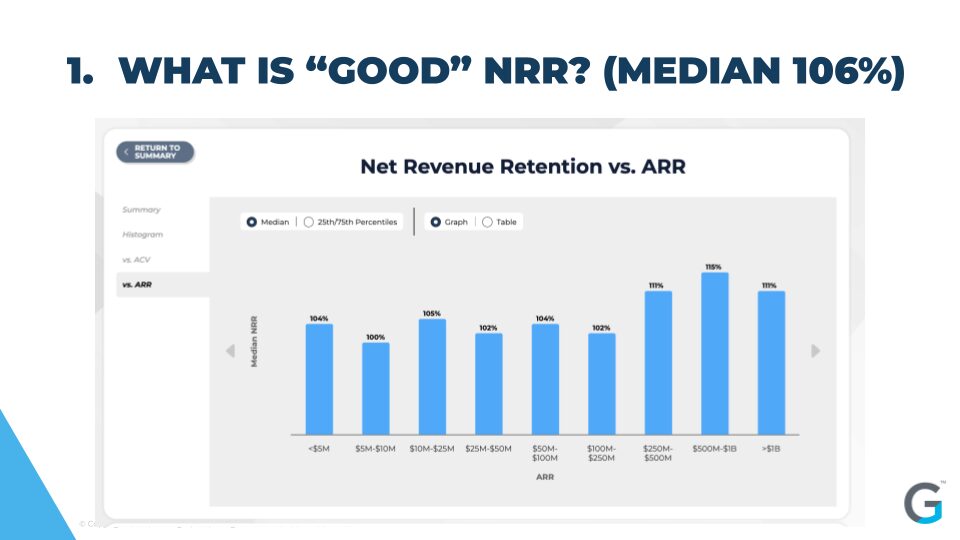
Maybe no surprise the #1 question they get is “What should my Net Revenue Retention be?.” What’s ‘good vs. bad’ NRR?
So one caveat if you’re googling what your NRR should be – be sure to look at the data source as most NRR studies or reports are based on public company data, which provides great benchmarks, but it may not always be accessible for smaller and private companies. However, using data from Gainsight’s new benchmarking tool releasing soon, Nick reveals that a hundred percent net retention is quite common for younger companies, and the percentage naturally grows as the company expands its product offerings, with a median of 106% NRR.
“Don’t feel bad about 100% NRR,” Nick suggests. “Try to do better. We are all trying to get better, but also understand where you are.”
2. What’s Good NPS? (Net Promoter Score):
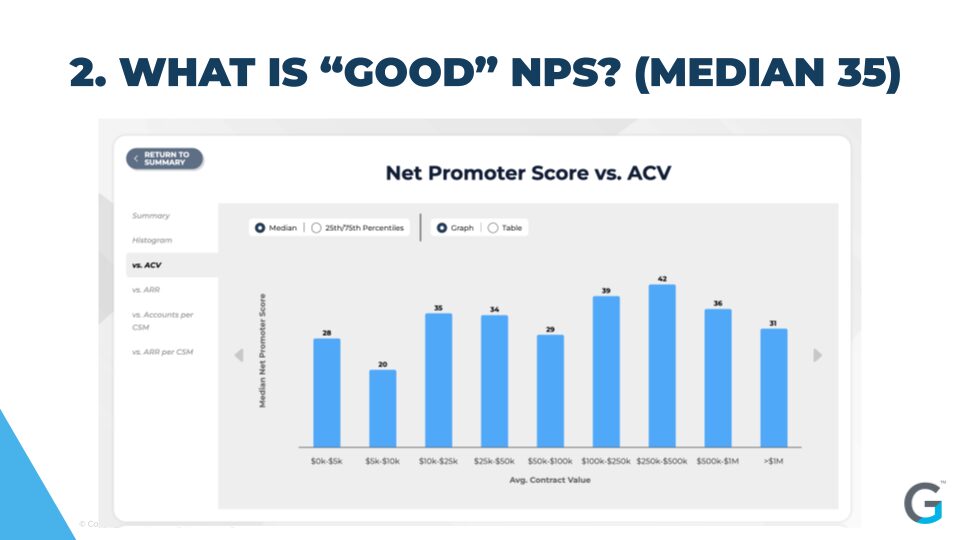
NPS is another crucial metric that we talk about a lot, but what should a company’s NPS be going into 2024? Nick shares that the median NPS for SaaS companies is 35, and interestingly, this metric is less influenced by factors such as customer size.
3. Who Should CS Report to and Should They Have a Quota?
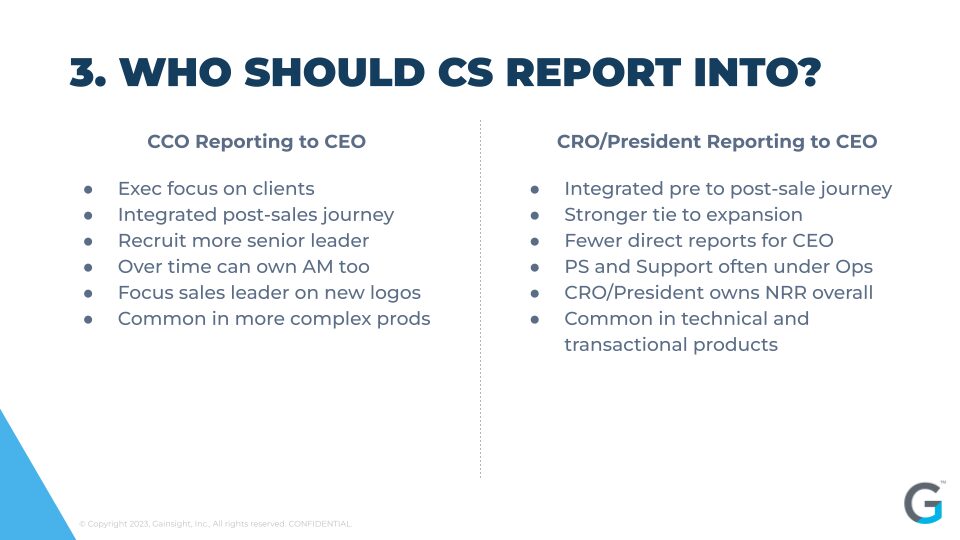
An often debated question within the SaaS community revolves around the reporting structure of CS teams: should you ultimately have a Chief Customer Officer (CCO) who reports directly to the CEO, emphasizing the focus on customer needs and an integrated journey across customer success, service, and support, OR, should you have a Chief Revenue Officer (CRO) or President lead CS to focus in on complex product offerings and shorter sales cycles?
On one hand when CS reports to the CCO, the exec team is going to be more focused on clients and client needs. Because of that, it allows you to create an integrated journey across customer success services support, and over time most CCOs will take over the existing sales, including renewal and expansion, and free up sales to focus on bringing in new logos. This approach is more commonly seen in SaaS with more complex products where professional services and longer contract durations are involved.
On the other hand, when CS reports to the CRO or a more sales-specific title, the benefits are there from integrating the pre and post-sale customer journey. The handoffs between sales and CS are more seamless and can often lead to higher expansion ratios since the CRO now owns net retention overall. This model is more common with technical SaaS products with a lot of land-and-expand customers or with transactional products with a very short sales cycle.
Related – regardless of who ultimately owns CS, should they have a quota?
Nick shares that in their sample data, 50% of CS organizations have a renewal quota, and 10% have an expansion quota. The presence of quotas varies depending on the nature of the business, with larger contracts tending to have CSMs carrying higher quotas.
4. What’s the ROI of the CS Team?
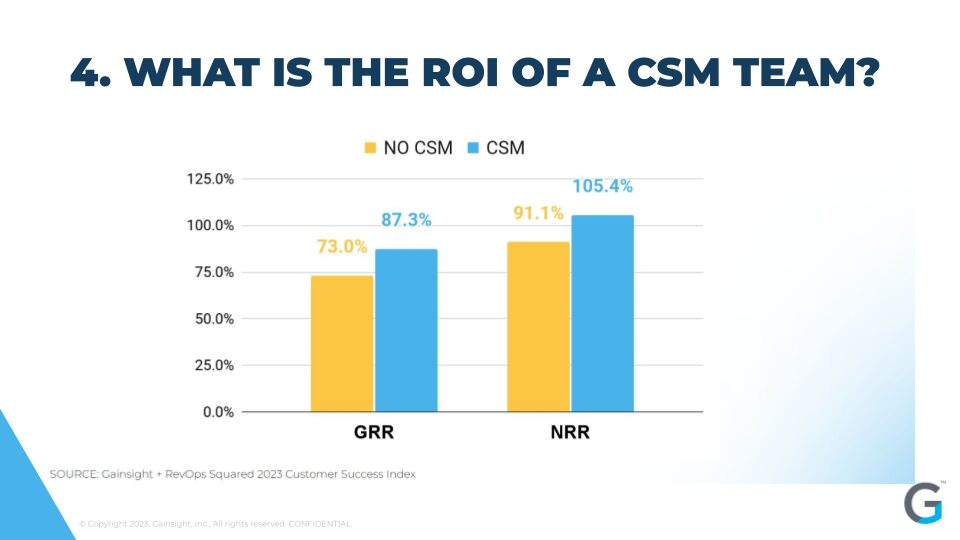
So in 2024, do you even need a customer success team?
Nick’s data above indicates that companies with a dedicated CS team have 14 points higher Gross Revenue Retention (GRR) and Net Revenue Retention (NRR). It also shows that while CS may not directly impact expansion, it effects it on a more pre-account individual basis and significantly raises the floor and provides stability.
5. How Much Should You Spend on a CSM?
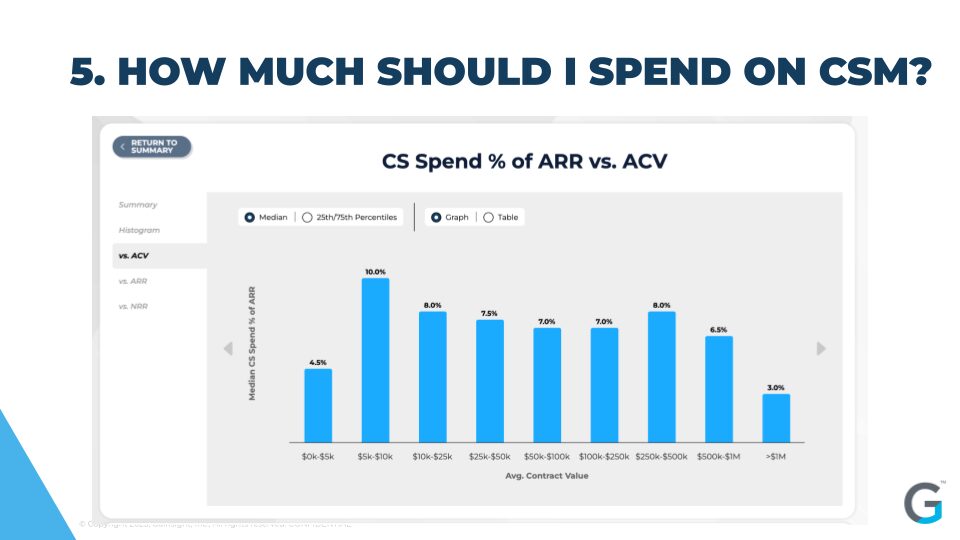
Next top question: “How much should I spend on customer success?”
A huge question in 2024 as you’re going through budgeting and becoming more efficient. One way people answer this question is as a percentage of ARR as shown in Nick’s chart above. Now, keep in mind this includes the CSMs as well as Ops and CS management. So on the left are your more transactional, almost self-service SaaS companies, and on the right side is where you have a very high-touch business, like million-dollar contracts like a Workday.
What you see here is pretty interesting, putting aside the very low end, which tends to have no CSM and more automation. As your contracts get bigger, your CS team should get more efficient. The truth is managing a million-dollar customer isn’t 10 times more work than managing a hundred-thousand-dollar customer.
And so you can see the benefit of higher ASPs (average sale prices). Bigger ASPs can become more efficient.
What’s more interesting, is oftentimes Jason will see companies in $5-$10K, 10% segment above and notices they’ll usually have more employees in CS, than they do in sales. And as you go down this chart, that starts to flip.
6. What’s the Ideal Number of Accounts An Individual CSM Can Manage?
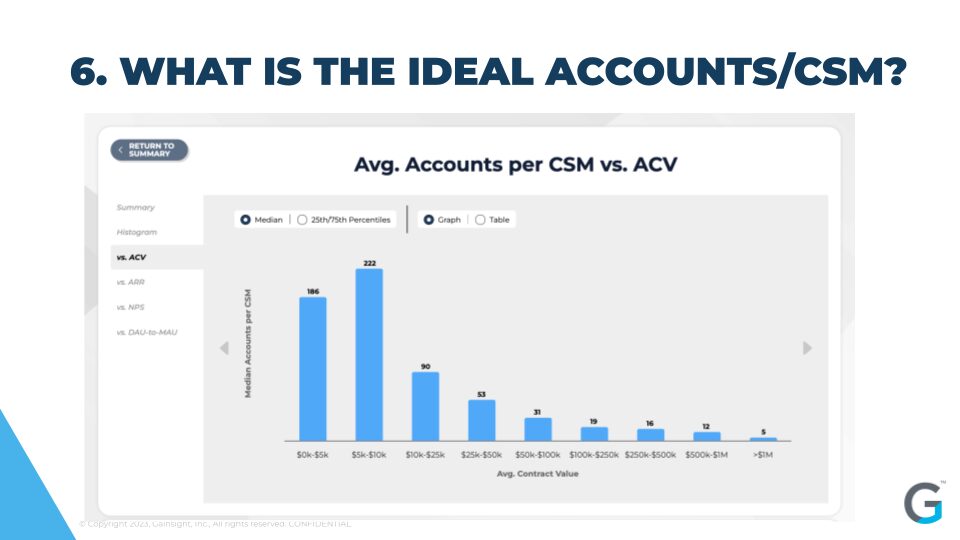
OK, onto the next burning question. How many accounts should any one individual Customer Success Manager have?
On the low end, is typically to see companies under $25K ACV have a couple of hundred accounts per person, typically quite automated. On the high end, you can see why it’s so efficient (ala point # 5), and that’s because you can manage five accounts and a total account value of $5 million. A related deep dive on that here.
Related to this is how much ARR should each CSM carrying?
Maybe no surprise that you get to big contracts, CSMs are carrying on average $10M ARR each. Now, if you’re a startup, that’s just not realistic, but as you scale you start to become more efficient, introduce more automation, maybe have CSMs outside of high-cost territories, and so on.
7. How Can I Scale CS Efficiently?
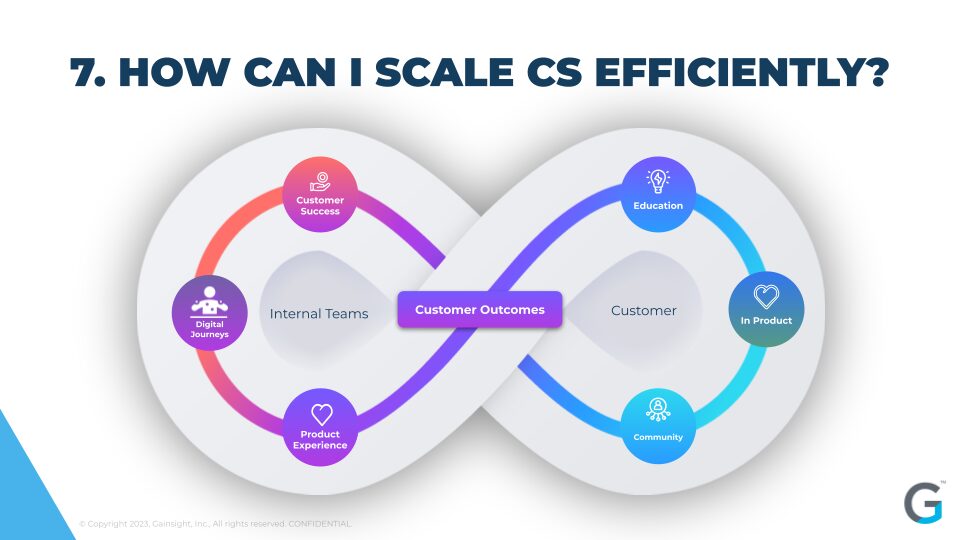
Beyond the ‘basics,’ one of the burning questions in Customer Success in 2024 is how to scale it efficiently?
Nobody is out there blindly hiring a thousand customer success reps these days. There are 4 things Nick suggests for creating efficiencies:
- Scale by creating a wealth of digital resources for your customers
- Make CS a revenue center by monetizing it as part of an overall service package
- Have CS own renewals or expansion
- Set up a very clear line between CS and revenue impact
What you want to avoid is having CS be a pure cost center. Remember that customer success is more than just hiring CSMs. Analyze the whole life cycle and see how much you can do in an automated way. Looking at the chart above, Nick’s identified activities both internal and external at your organization to help scale CS more efficiently.
On the left are the things you can do internally, like creating a lot of digital journeys and content for customers to self-serve (customer forums, help centers, in-app guides, etc.), and improving the product experience with fixes and features. CS can layer in by creating communities and feedback loops with customers to gain more efficiencies.
8. What Should You Invest in CS Operations?
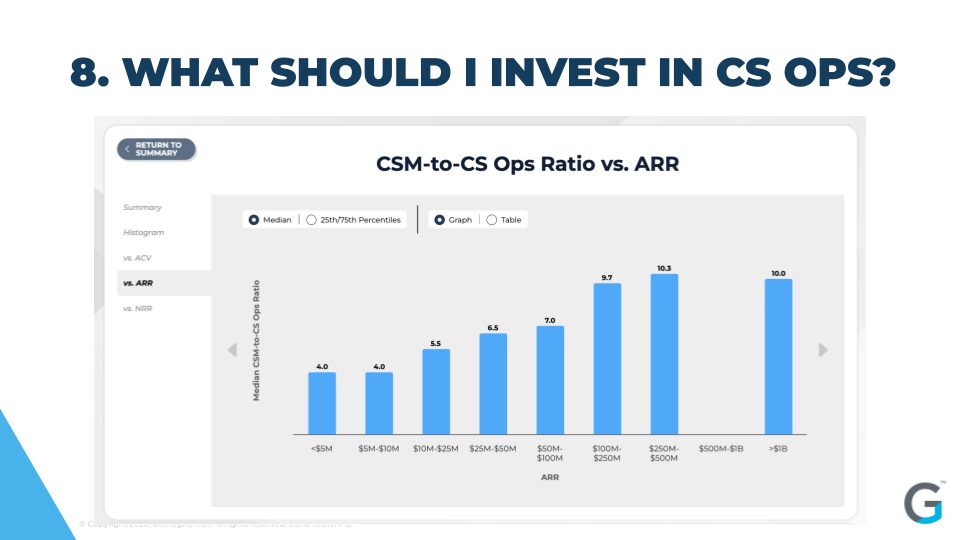
In a similar trend to scaling sales with sales ops, Nick is seeing more companies invest in CS Ops. The chart above shows the number of CSMs per ops person. So in some ways the higher the number, the fewer ops people on a relative basis. And the reason this goes up is as you scale, you have more people and more leverage overall in the company.
But what they’re seeing is in the early days of a company, this is ARR. So the early days on the left, people are investing in ops very early on because all the automation that was talked about in #7 should fall to the CS Ops team. It’s not just all about CSMs.
9. Do You Need to be a Product Expert in Customer Success Today?
Both Nick and Jason agreed on this question and the answer is this — you have to be pretty darn good at product. In fact, you should know it cold. Now, it depends a little bit on the nature of your product since some technologies are really more about change management, and less about the product. But even then you have to know enough to support your most technical customers.
“I think it’s the death of the generalist in Customer Success,” Jason predicts. “A CS person that’s actually a good guy, but not good at product, not good at change management. And that’s an email forwarder. We don’t need that person. That person may even be replaced with a bot. When you hire a CS folks, as them ‘what are you great at in CS?’ And if they just say, ‘I’m a people person,’ I might pass on that hire.
10. Do We Even Need Customer Success in 2024?
Last but not least, do Jason and Nick think we even need customer success anymore in 2024? Frank Slootman, CEO of Snowflake said in his book Amp it Up that “Customer success is the mission of the entire company ..why do you need an entire dedicated department?”
Nick explains: “If you are a company that has unlimited demand, and everyone needs it, and you’re like the Michael Jordan of CEOs, then you probably don’t need CS. But I will just say that for most companies, the customer expects you to drive the outcome. You can’t just charge ’em for it. You can’t just do it through sales. I’ve seen all of these movies and frankly, every single company that cuts their team regrets it a hundred percent.”
So there’s your answer 🙂

